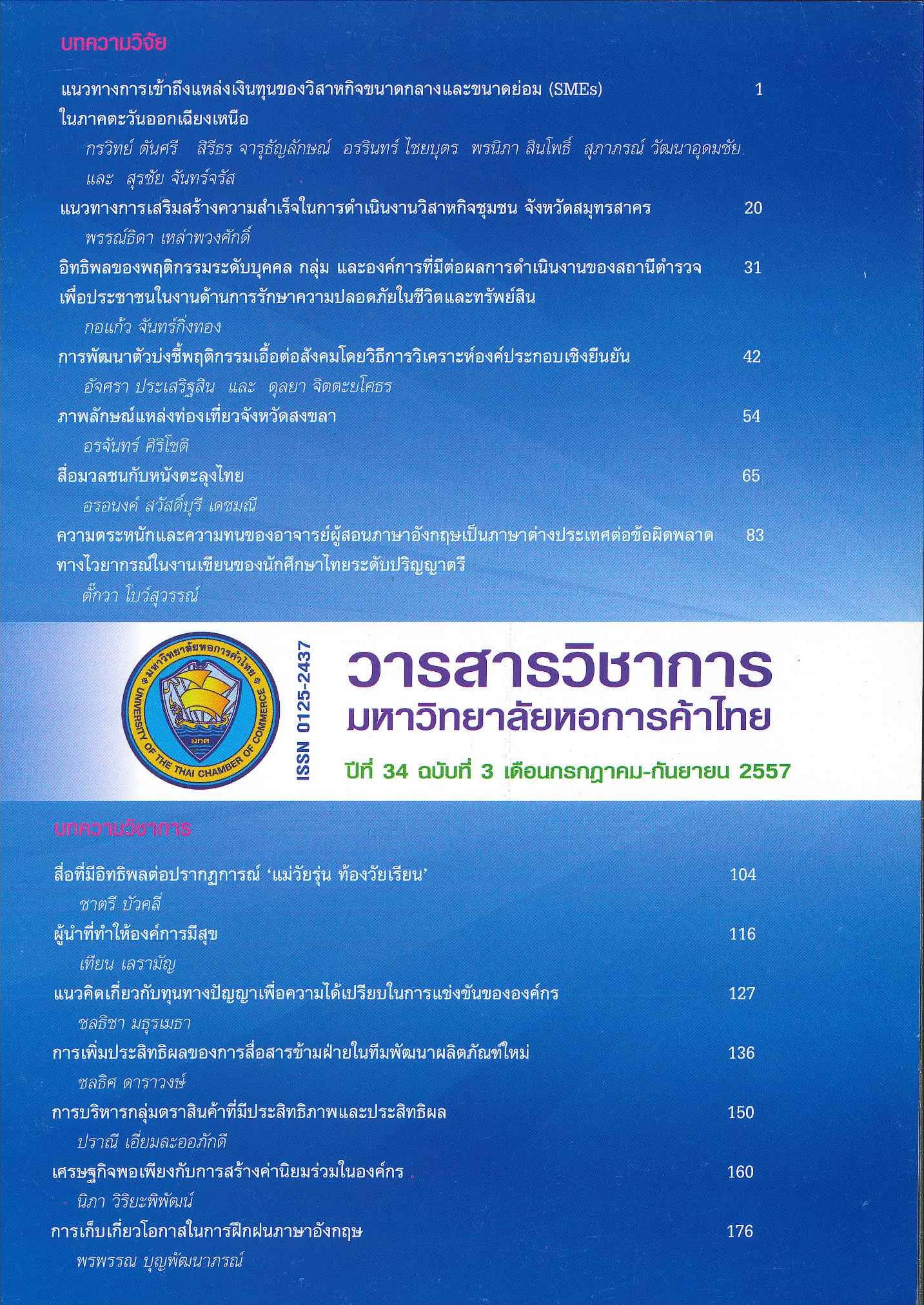Intellectual Capital Concepts for Competitive Advantages
Main Article Content
Abstract
This review paper integrates and reviews literatures of the intellectual capital concepts. The review topics are separated into four parts: (1) the importance of the resource-based view of the firm to the intellectual capital concepts, (2) the principles of intellectual capital, (3) the effects of intellectual capital on the competitive advantage of organizations, and (4) conclusion. In addition, concern of the organization management and resource management to be successful has been discussed and suggested.
Article Details

This work is licensed under a Creative Commons Attribution-NonCommercial-NoDerivatives 4.0 International License.
ลิขสิทธิ์ของบทความ
ผลงานที่ได้รับการตีพิมพ์ถือเป็นลิขสิทธิ์ของมหาวิทยาลัยหอการค้าไทย ห้ามมิให้นำเนื้อหา ทัศนะ หรือข้อคิดเห็นใด ๆ ของผลงานไปทำซ้ำ ดัดแปลง หรือเผยแพร่ ไม่ว่าทั้งหมดหรือบางส่วนโดยไม่ได้รับอนุญาตเป็นลายลักษณ์อักษรจากมหาวิทยาลัยหอการค้าไทยก่อน
References
Bontis, N., Keow, W.C.C., and Richardson, S. 2000. “Intellectual Capital and Business Performance in Malaysian Industries.” Journal Intellectual Capital 1, 1: 85-100.
Bueno, E., Salmador, M.P., and Rodriguez, O. 2004. “The Role of Social Capital in Today’s Economy.” Journal of Intellectual Capital 5, 4: 556-574.
Chen, A., and Chen, R. 2007. “Design Patent Map: An Innovative Measure for Corporative Design Strategies.” Engineering Management Journal 19, 3: 14-29.
Chen, J., Zhu, Z., and Xie, H.Y. 2004. “Measuring Intellectual Capital: A New Model and Empirical Study.” Journal of Intellectual Capital 5, 1: 195-212.
Cortini, M., and Benevene, P. 2010. “Interaction Between Structural and Human Capital in Italian NPO: Leadership, Organizational Culture and Human Resource Management.” Journal of Intellectual Capital 11, 2: 123-139.
Dehning, B., and Stratopoulos, T. 2003. “Determinants of a Sustainable Competitive Advantage Due to an IT-Enabled Strategy.” Strategic Information Systems 12: 7-28.
Edvinsson, L., and Sullivan, P. 1996. “Developing a Model for Managing Intellectual Capital.” European Management Journal 14, 4: 356-364.
Galbreath, J. 2005. “Which Resources Matter the Most to Firm Success? An Exploratory Study of Resource-Based Theory.” Technovation 25: 979-987.
Hall, R. 1992. “The Strategic Analysis of Intangible Resources.” Strategic Management Journal 13, 2: 135-144.
Hsu, Y.H., and Fang, W. 2009. “Intellectual Capital and New Product Development Performance: The Mediating Role of Organizational Learning Capability.” Technological Forecasting & Social Change 76: 664-677.
Huang, C.J., and Liu, C.I. 2005. “Exploration for the Relationship Between Innovation, IT and Performance.” Journal of Intellectual Capital 13, 2: 237-252.
Intan-Soraya, R., and Chew, K.W. 2010. “A Framework for Human Resources Management in the Knowledge Economy: Building Intellectual Capital and Innovative Capability.” Human Resources Management in the Knowledge Economy 3, 2: 251-273.
Mathuramaytha, C. 2012. “The Impact of Intellectual Capital on Innovative Capability: Building the Sustain Competitive Advantage on a Resource-Based Perspective of Thailand Industrials.” International Business Management 6, 4: 451-457.
Montes, F., Moreno, A., and Fernandez, L. 2004. “Assessing the Organizational Climate and Contractual Relationship for Perceptions of Support for Innovation.” International Journal of Manpower 25, 2: 167-180.
Osbome, A. 1998. “Measuring Intellectual Capital: The Real Value of Company.” Ohio CPA Journal 57, 4: 37-38.
Pena, I. 2002. “Intellectual Capital and Business Start-Up Success.” Journal of Intellectual Capital 3, 2: 180-198.
Peng, T.A. 2011. “Resource Fit in Inter-Firm Partnership: Intellectual Capital Perspective.” Journal of Intellectual Capital 12, 3: 20-42.
Ramezan, M. 2011. “Intellectual Capital and Organizational Organic Structure in Knowledge Society: How are These Concepts Related?” International Journal of Information Management 31: 88-95.
Ross, J.W., Beath, C.M., and Goodhue, D.L. 1996. “Developing Long-Term Competitiveness through IT Assets.” Sloan Management Review 38, 1: 31-42.
Rude, H.N., and Mihalič, T. 2007. “Intellectual Capital in the Hotel Industry: A Case Study from Slovenia.” Hospitality Management 26: 188-199
Seleim, A.A.S., and Khalil, O.E.M. 2011. “Understanding the Knowledge Management-Intellectual Capital Relationship: A Two-Way Analysis.” Journal of Intellectual Capital 12, 4: 586-614.
Striukova, L., Unerman, J., and Guthrie, J. 2008. “Corporate Reporting of Intellectual Capital: Evidence from UK companies.” The British Accounting Review 40: 297-313.
Sullivan, H.P. 1999 “Profiting from Intellectual Capital.” Journal of Knowledge Management 3, 2: 132 – 143.
Yitmen, I. 2011. “Intellectual Capital: A Competitive Asset for Driving Innovation in Engineering Design Firms.” Engineering Management Journal 23, 2: 3-19.


